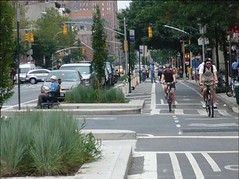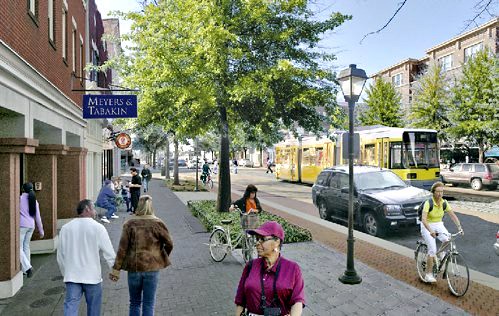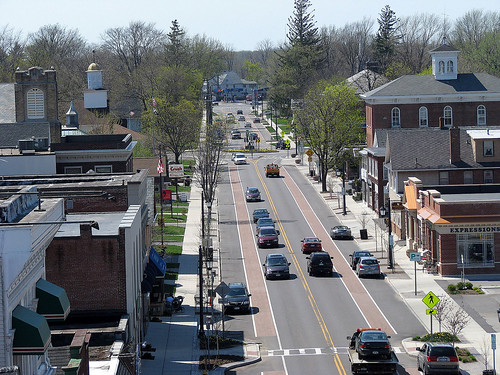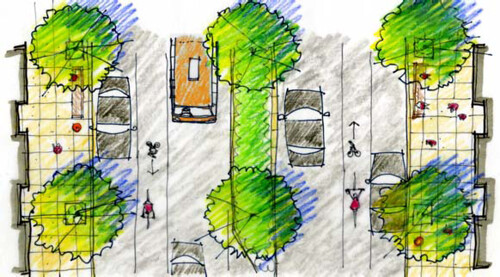Complete streets policies are gaining popularity across the country

Posted April 27, 2011 at 2:00PM
While the prospects for transportation policy reform appear stagnated at the federal level, more and more state and local governments across the country are adopting strong “complete streets” measures, according to a new analysis by the National Complete Streets Coalition (NRDC is a member). The new report documents the tremendous growth in adoption of policies to ensure that future transportation infrastructure investments provide safe options for everyone using roadways and sidewalks.
In particular, the number of complete streets policies - which assure that street design and management account for pedestrians, transit users and bicyclists in addition to motorists - in place came close to doubling in each of the last three years, according to a press release issued today by the Coalition. Twenty-three states (along with Puerto Rico and DC)  and more than 200 smaller jurisdictions now have such policies.
and more than 200 smaller jurisdictions now have such policies.
“Recent polls show that voters’ top priority for infrastructure investments are safer streets for our communities and children,” said Barbara McCann, National Complete Streets Coalition Executive Director, in the release. “Our report shows that this commitment is not only wide, but deep: community leaders and transportation practitioners are rolling up their sleeves and working together in small towns and big cities, in almost every state in the nation, to pass policies that will ensure that future transportation investments create complete streets.”
The report, Complete Streets Policy Analysis 2010: A story of growing strength, rates more than 200 state and local measures against ten key elements of ideal complete-streets policies. Among the top scoring are state policies in the deep South and Midwest, county actions in Florida and the Mountain West, and city ordinances and design guidance in the Pacific Northwest and the Northeast. Forty-seven states now have at least one such policy, with suburban communities of fewer than 30,000 residents comprising the largest percentage of adopters by size and location.
The approaches vary. For example, New Jersey’s statewide policy takes the approach of establishing principles to follow. It requires, among other things, that all road projects (with limited exceptions) use a checklist to assure the provision of such pedestrian, bicycle and transit accommodations as accessible sidewalks, curb ramps, crosswalks, countdown pedestrian signals, signs, median refuges, curb extensions, pedestrian scale lighting, bike lanes, shoulders, and bus shelters. Additionally, “the design of intersections, interchanges and bridges [used for roadway crossings] shall accommodate bicyclists and pedestrians in a manner that is safe, accessible and convenient.”
Tacoma, Washington has adopted a more detailed set of complete streets design guidelines, differentiated for mixed-use centers and residential areas, and various street typologies within them. The mixed-use guidelines, for example, set different presumptive standards for Main Streets, Avenues, Transit Priority streets, and Urban Residential streets. For Main Streets the guidelines specify, among other things, generous sidewalk and amenity zones, short blocks, parking on both sides, and separate bicycle lanes; Urban Neighborhood streets are to have parking on “at least one side,” wider sidewalks “where possible,” and green stormwater infrastructure such as “bioretention swales, rain gardens, additional street trees [and] pervious pavement.”
The report should help communities seeking to adopt effective measures of their own find a variety of good models to follow.
The report’s top-rated policies:
- New Jersey Department of Transportation – Policy No. 703
- Louisiana Department of Transportation – Complete Streets Policy
- State of Minnesota – Statutes 174.75
- State of Connecticut – Public Act 09-154
- Mid-Ohio Regional Planning Commission – Complete Streets Policy
- Bloomington/Monroe County, IN Metropolitan Planning Organization – Complete Streets Policy
- Hennepin County, MN – Complete Streets Policy
- Lee County, FL – Resolution No. 09-11-13
- Salt Lake County, UT – Ordinance No. 1672
- Crystal City, MO – Ordinance
- Roanoke, VA – Complete Streets Policy
- Missoula, MT – Resolution No. 7473
- Herculaneum, MO – Ordinance No. 33-2010
- New Haven, CT – Complete Streets Design Manual
- Tacoma, WA – Complete Streets Design Guidelines
The National Complete Streets Coalition brings together public interest groups such as AARP, the American Public Transportation Association, and America Bikes, as well as professional associations such as the Institute of Transportation Engineers, the American Society of Landscape Architects, and the Association of Pedestrian and Bicycle Professionals. The new report may be downloaded in full here.
Move your cursor over the images for credit information.


